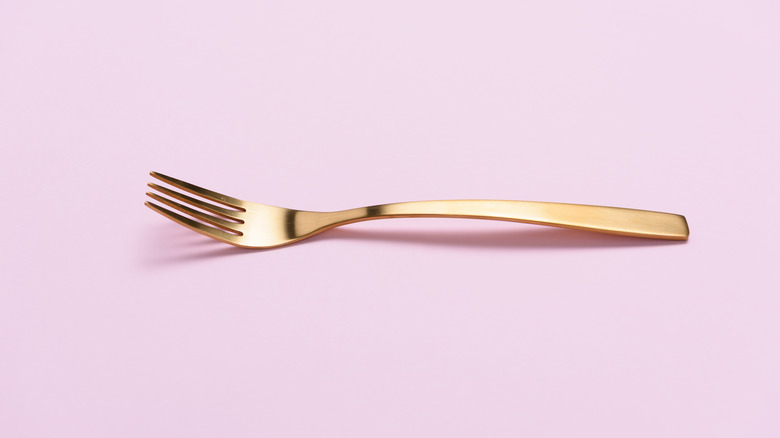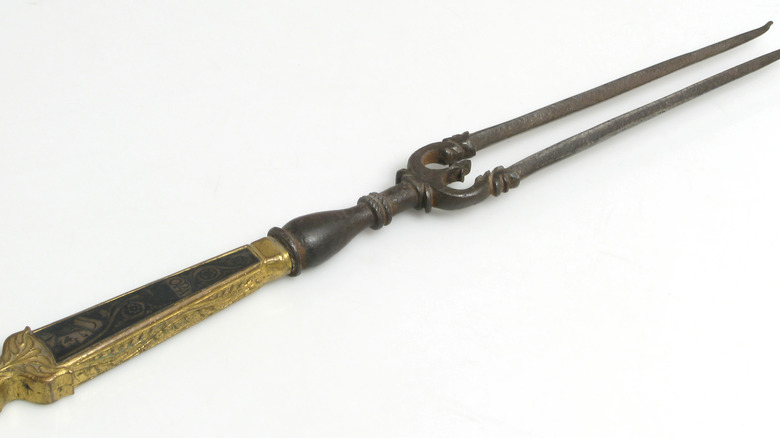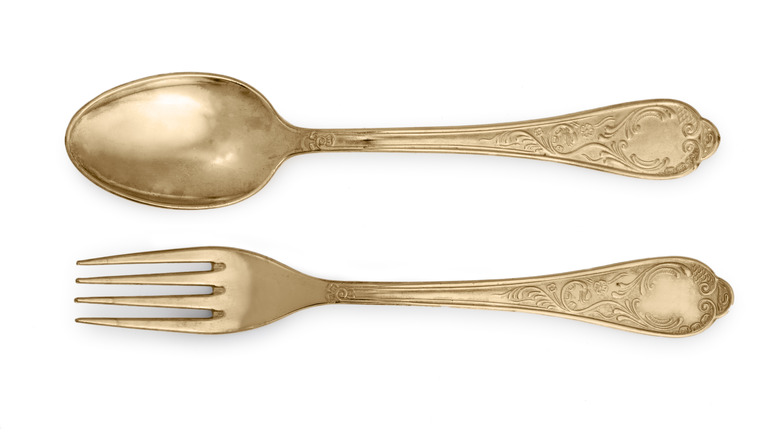Early Versions Of Forks Had A Reputation For Being 'Too Feminine'
Western culinary culture stands upon three mighty pillars: the knife, the spoon, and the fork. One of these things is not like the others. While knives and spoons are living relics of our primitive past, the fork is much newer — a disruptor in the flatware world. Knives and spoons have been part of our lives for all of recorded history, knives being clear descendants of the hand axes that are widely regarded as the world's oldest tools, while the first spoons were likely made from any scoop-shaped object one could find. The Latin word for spoon – 'cochleari' – comes from 'cochlea,' a term for spiral-shaped shells, while the Anglo-Saxon 'spon,' from which we derive our term for the tool, means 'wood chip.' Armed with these two utensils, humankind ate its way through multiple millennia, never thinking of adding another member to the group.
How did Europeans navigate mealtime without forks? The answer is: messily. The fork's role was once performed by hands. Everything solid was finger food. In Medieval times, people used slices of stale bread called 'tenchers' in place of plates, and these could be used to shovel food toward the mouth. Every other task could be managed with a knife or a spoon. However, this came at the expense of hygiene, as people were using their food-covered fingers to pick from communal platters and typically wiped their hands on the tablecloth. Another utensil was necessary to refine our dining habits.
Forks originally served a different purpose
When forks ultimately made it to our tables, they weren't exactly a revolutionary invention. Similar tools had been used before, albeit for different purposes such as weaponry. The most iconic example would be the trident, the three-pronged spear favored by Poseidon and the Little Mermaid's dad. Ancient Greeks also used large utensils with two sharp prongs (similar to carving forks) to lift food out of boiling hot pots. This may have been the first time a fork-like tool was used in association with food, but it is important to note that these utensils were exclusively used in the kitchen, and were not part of table settings. Even the word 'fork' has roots that precede its role at the table, being derived from 'furca,' a Latin term used specifically in reference to pitchforks.
The fork assumed its modern role in the Middle East, with some evidence suggesting that Persian nobility used them as early as the eighth century. We know that they were definitely in use in the Byzantine Empire by the early 1000s, as a manuscript from that period includes an illustration of two men at a table, each with a fork (albeit of the two-pronged variety). Moreover, when Maria Argyropoulina, the niece of the Byzantine Emperor, married the son of the Doge of Venice in 1004, she brought with her a set of two golden forks. When she used them at her wedding feast, the Venetians weren't just stunned; they were incensed.
Forks caused a crisis of masculinity
The Europeans, who still ate with their hands, thought that Maria Argyropoulina's actions were decadent to the point of sin. Some considered her golden forks an insult to God, reasoning that the Lord had already provided human beings with natural forks in the form of fingers. Maria Argyropoulina died of the plague two years after her wedding, which prompted a criticism from St. Peter Damian, a notable cardinal of the Church. According to Slate, he wrote, "Nor did she deign to touch her food with her fingers, but would command her eunuchs to cut it up into small pieces, which she would impale on a certain golden instrument with two prongs and thus carry to her mouth." Damian surmised that, "this woman's vanity was hateful to Almighty God; and so, unmistakably, did He take his revenge."
The validity of this statement is questionable, as St. Peter Damian was not born until 1007. Regardless, the perspective reflected that of the Catholic Church, and forks gained a reputation as symbols of vanity. They were widely associated with wealthy women, as, in addition to Maria Argyropoulina, Catherine de Medici played a major role in introducing them to Europe. This challenged the fragile masculinity of some, particularly the British, who criticized the use of forks as a 'feminine affectation,' according to the Royal Museums Greenwich. British sailors were recorded using their hands in place of forks as late as 1897, but inevitably, practicality and hygiene won out.


